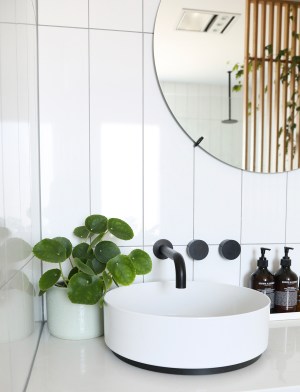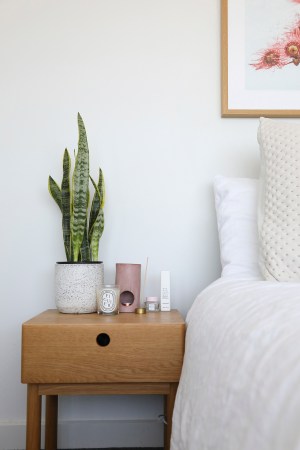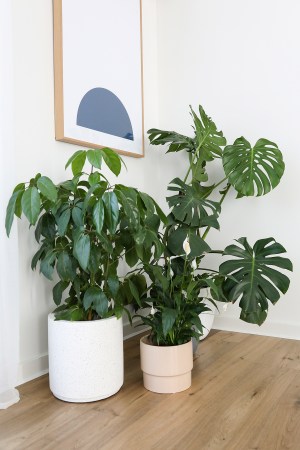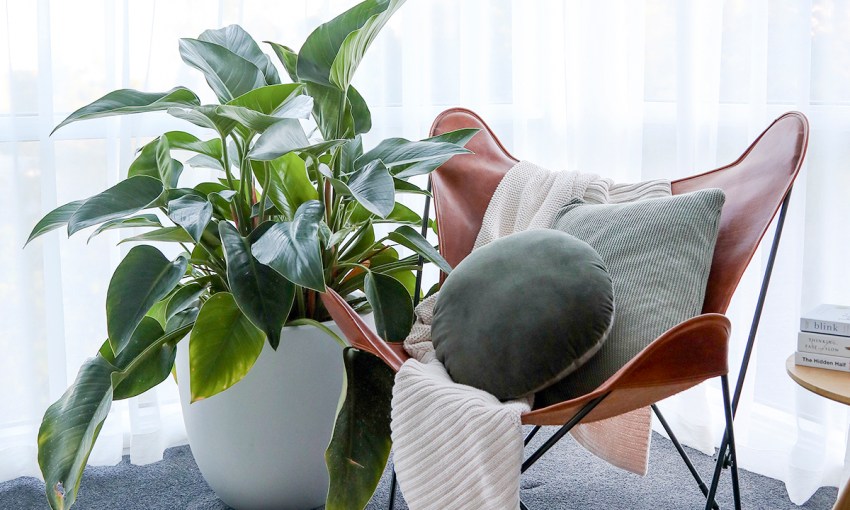Whether you have a bright, sunny windowsill or a dark, dull corner to decorate, indoor plants in all their variety can enliven any part of the home – and cheer you up in the process.
In the garden: The Great Indoors
It’s true what they say: plants make people happy. Surrounding yourself with indoor plants not only enhances the appearance of a space, but it is proven they boost your mood, inspire ideas and create a sense of tranquillity. Whether it’s a small collection of potted plants on a windowsill, or a display of large showstoppers, adding some greenery into your spaces can make for a healthier, happier you.
Bedrooms and bathrooms should be spaces to relax and recharge, and adding greenery can go a long way in achieving a true sense of serenity. As these rooms tend to be cosy and receive only partial direct sunlight, the key is to find foliage plants that thrive in indirect light.

If you want to add some cheer to a windowsill, bedside table or bathroom vanity, a Pilea peperomioides (Chinese money plant) is a fantastic choice. To keep a Pilea happy, choose a bright position but avoid direct afternoon sun, as this may damage the fleshy leaves, and ensure it has adequate drainage. Maidenhair, asparagus and Boston ferns are great too, particularly in the bathroom where humidity is higher.
Perhaps you’d like to add some privacy or hide an uninspiring outside view to create a more secluded haven for yourself. Hanging baskets of a trailing plant such as an Epipremnum (devil’s ivy), or a Philodendron variety will instantly help create a little privacy to any exposed room. Both species grow in low light and are delightfully forgiving to forgetful owners. Just ensure you keep their soils moist in spring and summer, reducing watering in winter to avoid damage to their roots.
Where you have more room, such as in vacant corners or that awkward nook you don’t quite know what to do with, a curated collection of plants can bring an entire space to life — larger growing tropical plants of contrasting colours, textures and foliage are perfect for this. You can also play around with the addition of plant stands and decorative pots to give the space depth and interest. Another positive of grouping plants together is that you can increase humidity and reduce their watering needs.
The best plants for clustering are those that require minimal care and maintenance, yet are full of character. The Monstera deliciosa (swiss cheese plant) is a perfect example, adding an instant hit of luscious green with its sprawling, intricately-shaped leaves. With a weekly watering regime and a moss-covered pole as a support to grow upon, it requires very little attention for the reward you’ll receive. Difficult to pronounce, but super easy to care for, a Schefflera (umbrella tree) will also add charm to your space with its exquisite glossy, umbrella-like leaves. Whilst very low maintenance, do ensure it receives adequate light, as too little light may cause it to become leggy and sparse.
When grouped with other hardy species such as a Ficus elastica (rubber plant), Kentia palm, or ever-popular Strelitzia nicolai (bird of paradise), your cluster of plants will create an enviably intense pocket of greenery.

The perfect place to introduce a touch of greenery is your workspace. It doesn’t matter if your space is in immaculate order or a charming clutter of paperwork, a plant can be a wonderful addition to boost productivity and promote calmness. If you are lucky enough to work in a brightly lit space, a Peperomia argyeria (watermelon plant) would make the perfect work companion with its attractively-striped foliage and preference to dry out between waterings, demanding little attention. If you have room for a larger plant by your desk, a Ficus lyrata (fiddle leaf fig) will do well in indirect light, just keep it away from the air conditioner, and remember to give it a little water when you have your morning coffee in summer, reducing watering in winter.
If plants with blooms are more your style, it’s hard to pass on a traditional phalaenopsis orchid or Anthurium, two easy-to-care-for beauties perfect for your kitchen windowsill or dining table. However, for something truly special, you could try your luck at finding a begonia “Angel Wings”. With its highly decorative spotty leaves and dainty pink flowers, this specimen will be a showstopper in any bright space — just remember to turn the pot occasionally so the leaves develop in all directions.
So much choice can be overwhelming so, if you’re unsure where to start, there are several resilient, forgiving species that will help you find your green thumb. A top choice is a Spathiphyllum (peace lily) as they are fantastic at communicating their needs to novice indoor gardeners. While it is ideal to keep their soil moist, if you happen to miss a watering, their leaves will droop to remind you they are thirsty, and bounce right back once watered. Thriving in indirect sunlight, this plant will produce brilliant white flowers in spring, giving you a beautiful reward for all your care.
If you’re after a fairly indestructible, low maintenance plant, a Zamioculcas variety or ZZ plant is for you. Sansevieria (Mother-in-law’s tongue) will withstand missed watering, survive in almost any lighting conditions and rarely need repotting. Their distinct vertical, marble-patterned leaves require no pruning and will bring a touch of textural magic to any space. Meanwhile the ZZ plant and its emerald green, glossy leaves is known to thrive in long periods of neglect, is immune to many common pests, and requires very little watering — in fact, overwatering is its biggest enemy as its bulbous tubers are vulnerable to root rot — so you can hardly go wrong!

Finally, all your plants will thrive if you give them the occasional mist of water to boost humidity, wipe their leaves with a damp cloth to remove dust and they’ll definitely appreciate a liquid feed in spring. Now that you’re equipped with some basic knowledge, head into your nearest garden centre to explore the world of indoor plants to start your journey of turning your home into a greener, healthier and more vibrant space — but be warned, buying indoor plants can be addictive…
This story first appeared in the May 2020 issue of SALIFE magazine.



